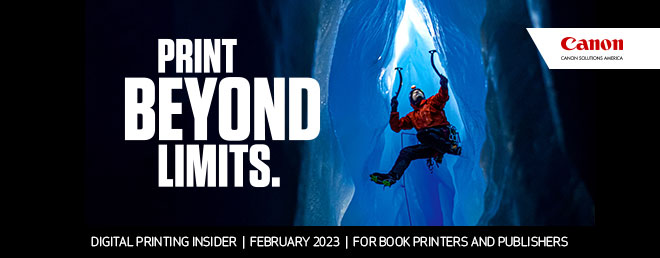Navigating Production Print Success in 2023
2023 will offer various opportunities for print service providers to profitably grow their operations, better meet customer needs, gain a competitive edge, and strengthen customer relationships.
A NAPCO Research report titled Production Digital Printing 2023: Planning for the Year Ahead identifies the top trends influencing the printing industry’s competitive landscape, recommendations for overcoming challenges, key application opportunities to pursue, and the role production digital printing can play in achieving success in 2023.
The report, based on ongoing NAPCO Research surveys, highlights nine key trends influencing competition, profitability, and technology investment in the year ahead.
Incorporating market trends and influences into business decisions oftentimes results in making the right moves and investments most likely to yield success. Print providers that make the right investments will enhance profitability, meet customer demands, and strengthen customer relationships. Here is a summary of key trends included in the report.
Seeking Ways to Minimize Labor Shortages
All industries across the United States, including printing, are experiencing challenges in finding workers. A recent NAPCO Research survey of commercial printers found that 69% identified hiring production staff as a critical/ moderate challenge.
One way print providers are addressing the labor challenge is by making investments in technology to automate processes. Over three-quarters of commercial printer (79%) and in-plant (85%) survey respondents participating in a 2022 NAPCO Research survey report their organizations are retooling operations to:
- Remove production bottlenecks that obstruct job volume throughput, hamper productivity, and strain profits.
- Minimize human touchpoints in print manufacturing to move jobs faster through the production process and reduce errors.
- Reduce staff requirements.
Investing to Expand Services
Increasing material and labor costs are squeezing commercial printers’ profitability while customers still expect high-quality products and services at competitive prices. According to a 2022 NAPCO Research survey, commercial printers are making investments to automate, upgrade, enhance services, and grow.
Production inkjet is a key investment area for commercial printers. Over half of commercial printers (61%) responding to a 2022 NAPCO Research survey report adding high-speed production inkjet.
Commercial printers’ investment in production inkjet will continue because it offers the following benefits:
- Extension of the crossover point for digital print versus offset, enabling more pages to migrate to digital print.
- More variable data options to personalize printed materials
- Printing of high-quality graphics, as some presses can print in 1,200 dpi resolution
- Support for a wide range of substrates.
- Production of both high-volume and short-run jobs (made possible by the speed, productivity, reliability, low running costs, and high levels of automation of today’s presses).
In-Plants Making Moves to Better Serve Parent Organizations
In-house printing operations are making moves to better serve their parent organizations, address competitive challenges, pursue new opportunities, and expand services.
In-plants are adding capabilities beyond print to build stronger bonds with the departments they serve, making parent organizations less likely to outsource work over a minimal cost difference. Additionally, these services can create new and recurring revenue streams. In-plants participating in a 2022 NAPCO Research survey report offering the following:
- Nearly all in-plant respondents offer bindery services and digital toner printing.
- Over 80% of in-plants report offering wide-format inkjet printing and variable-data printing.
- A majority of in-plant respondents offer prepress services (80%), graphic design services (79%), and online ordering (71%)
- Over two-thirds of in-plant respondents offer mailing (69%) and print procurement services (68%), while over half offer warehousing fulfillment (51%).
In addition, 38% of in-plant respondents expect to add high-speed production inkjet to their operations. Production inkjet offers in-plants the opportunity to bring in new business, generate additional revenue, and produce more work. Key benefits include:
- Cost-effectively printing monochrome and color jobs on one press.
- Transitioning black-and-white applications to higher-value/higher-margin color products.
- Extending the crossover point for digital print versus offset, helping more pages migrate to digital print.
- Printing more personalized materials, which is particularly attractive for increasing communication response rates.
Digital Printing Strengthening the Power of Print Applications
Core print applications will continue to evolve and offer opportunities for print service providers. Here are the likely trends to influence book, direct mail, and transactional printing.
- Next Chapter in Book Printing. Book printers are continuing to invest in digital printing to create agile organizations capable of better meeting publishers’ dynamic needs. In NAPCO Research’s study The Role of Inkjet Printing and Automation in Powering Industry 4.0 in Book Publishing, 52% of book printers surveyed indicated that their books are printed on digital presses. When asked about the key factors in choosing to print books digitally or offset, 95% of respondents indicated run length was an important component. Digital printing technology continues to transform book manufacturing by offering print providers and publishers new options to improve efficiency and profitability.
- Direct Mail Gets Smarter and More Effective. According to a 2022 NAPCO Research survey of communication buyers and influencers, 49% reported that use of direct mail increased in the last 12 months, and 43% expected further increases over the next two years. Technologies such as intelligent mail barcodes, quick response codes, and variable-data printing are enhancing direct mail’s value and its results. These tools are enhancing direct mail’s effectiveness because they enable delivery tracking, collect valuable lead data, and generate ROI.
- Transactional Documents: More Personal, Colorful, and Interactive. Not typically considered an eye-catching application, transactional documents are benefiting from inkjet’s higher levels of color, quality, and personalization. A noticeable trend in transactional documents is their evolution as marketing vehicles, mainly the result of production digital printing.
Final Thought
The challenge for print service providers is not a lack of opportunity but choosing the best opportunities to pursue. Download this full report below and use its trends, data points, and insights to craft strategies and evaluate investments in operations, equipment, staff, and market expansion.

